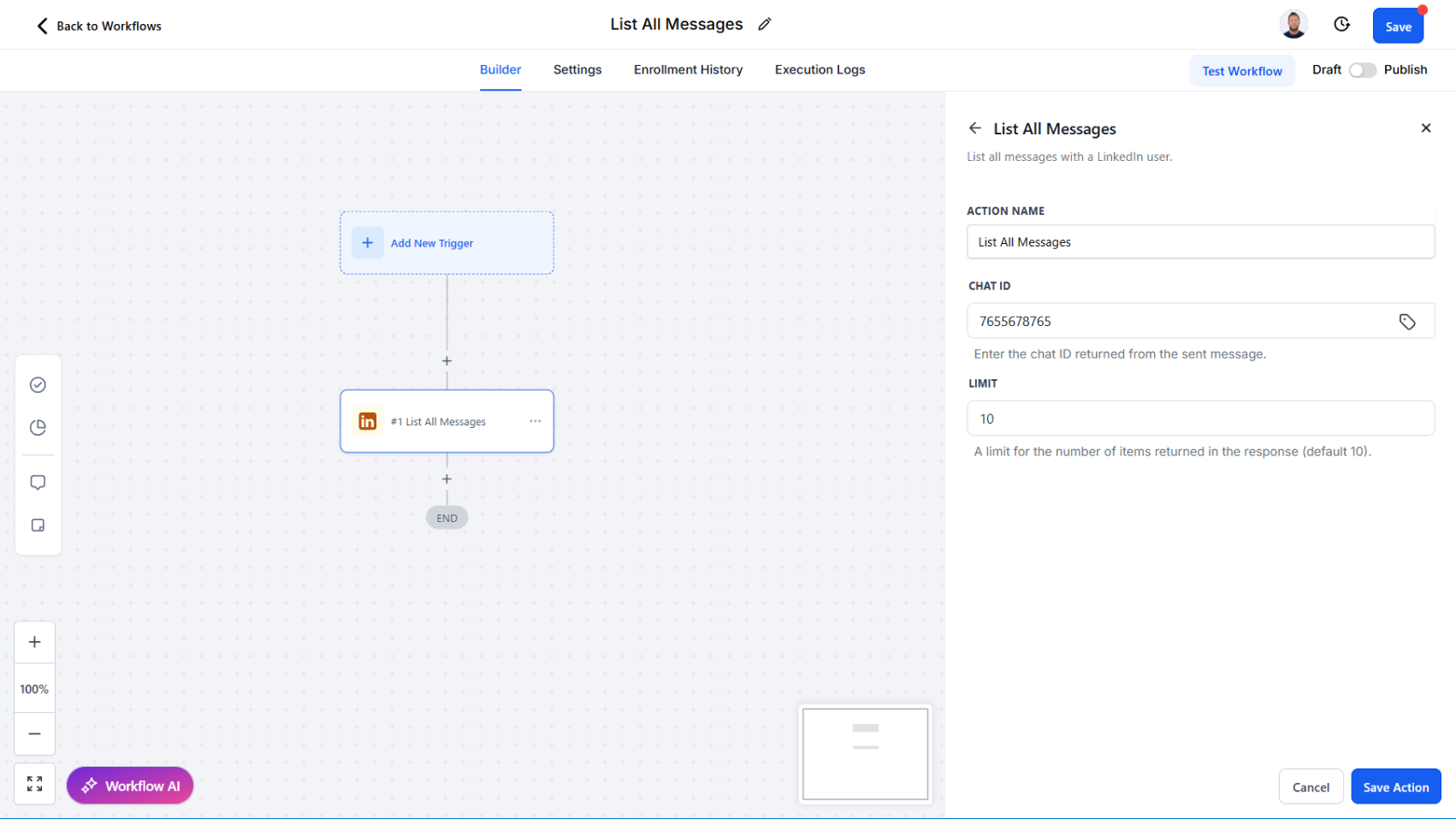List All Messages
Retrieve the message history from a LinkedIn conversation thread. Use this action to review past exchanges, provide context for AI-generated responses, or prepare before a sales or recruitment call.

Action Overview
The List All Messages action retrieves a set number of recent messages from an active LinkedIn conversation using the Chat ID. This makes it possible to review context, analyze conversation flow, or feed conversation history into AI for drafting the next response.
Use Cases
- AI-Powered Replies – Provide conversation history to an AI assistant to generate contextual follow-ups
- Pre-Call Preparation – Review recent messages before a scheduled call with a lead or candidate
- Conversation Tracking – Store message histories in CRM records for reference and compliance
Inputs and Required Data
Chat ID (required) – The identifier of the conversation you want to retrieve messages from
Example: urn:li:msg:conversation:2-AQc3Lk9dS
Limit (optional) – The maximum number of messages to retrieve (default: 10, max: 50)
Example: 10
Response
The List All Messages action returns:
- Messages – A list of messages from the specified chat thread. Each entry includes:
- Message ID – Unique identifier of the message
- Sender Name – Name of the sender
- Sender Public ID – LinkedIn Public ID of the sender
- Message Text – Content of the message
- Timestamp – Date and time the message was sent
- Attachment URL (if any) – Link to any attached files
Example Response (plain text)
Sender Name: John Smith
Sender Public ID: john-smith-12345
Message Text: Hi Sarah, just wanted to follow up on our last conversation.
Timestamp: 2024-08-20 14:35:21
Attachment URL: N/A
--
Message ID: 928473848
Sender Name: Sarah Johnson
Sender Public ID: sarah-johnson-67890
Message Text: Thanks John, I’ll review this week and get back to you. Timestamp: 2024-08-20 15:12:09
Attachment URL: https://example.com/brief.pdf
Obtaining Inputs
- Use Start A Chat or Retrieve A Chat ID to obtain the Chat ID.
- Set an appropriate Limit based on how much history you need (e.g., 5 for AI response drafting, 50 for full thread review).
Workflow Integration
- Trigger the Action – Run List All Messages when preparing to respond to a chat or before a scheduled call
- Process Results – Use retrieved messages for CRM record updates, analysis, or AI-driven workflows
- Next Steps – Chain with Send A Message To A Chat to send a contextual response
Related Actions
- Start A Chat – Begin a new conversation with a connection
- Send A Message To A Chat – Continue an existing conversation
- Retrieve A Chat ID – Obtain the identifier for a specific conversation
Common Errors and Troubleshooting
Invalid Chat ID
- Cause: The provided Chat ID does not exist or is incorrect
- Solution: Confirm it was retrieved from a valid preceding action
No Messages Found
- Cause: The conversation has no messages yet or the limit is set too low
- Solution: Increase the limit or verify the conversation activity
Best Practices
- Use this action before sending automated responses to ensure context is preserved
- Store retrieved messages in your CRM for compliance and reference
- Limit retrieval to only what’s needed (e.g., last 10 messages) to optimize performance
Advanced Tips
- AI Integration – Pass retrieved messages into an AI workflow to draft the next message with full context
- Sentiment Tracking – Analyze tone or keywords across retrieved messages to guide follow-up strategies
- Conversation Archiving – Periodically store entire chat histories for key accounts